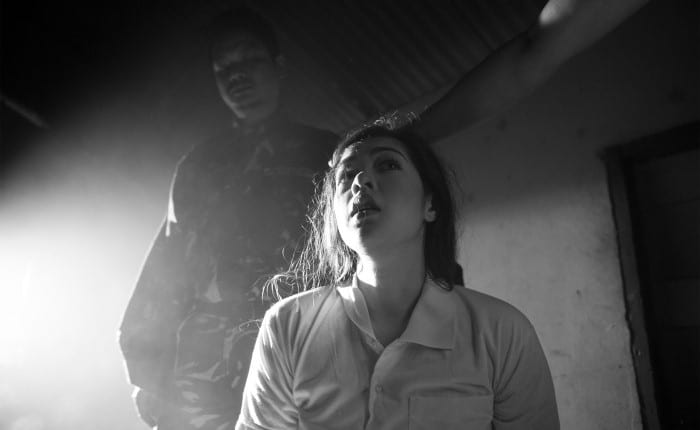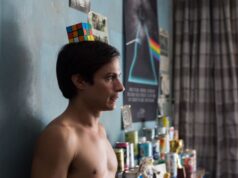Seventh-day coverage of the 68th Berlin International Film Festival with reviews of Lav Diaz’s Season of the Devil and Gus Van Sant’s Don’t Worry, He Won’t Get Far on Foot
Season of the Devil (Ang Panahon ng Halimaw)
The idea of a Philippine mixture of musical and historical drama conceived by Lav Diaz — or, as the filmmaker describes it, a “Philippine rock opera” — is quite curious. Shot in a gloomy black and white with an aspect ratio of 1.66:1 and an imposing length of almost four hours (234 minutes, to be more precise), this can only sound like something radically different from a Broadway-like experience. Indeed, Diaz is known for his elongated works, having made films such as Norte, the End of History (2013) and The Woman Who Left (2016), whose bloated structures are not always easy to justify. With Season of the Devil, that is not different, and those acquainted with his style will have a pretty good idea what to expect here.
Dedicated to the victims of the atrocities committed during Ferdinand Marcos’s dictatorship and martial law, the film is based on actual accounts and takes place in 1979, when a paramilitary militia is seen spreading terror at a remote village in the Philippine jungle. The atmosphere is oppressive, and they sing about witches, vampires, Tikbalangs and other subversives they want to eradicate from society so that “certainty” (another word for imposed common ideal) can prevail. In the midst of all this, doctor Lorena (Shaina Magdayao) arrives to open a clinic for the poor but disappears not so long after. Her poet husband Hugo (Piolo Pascual), who believes “certainty” is what’s creating monsters, decides to go to the village and find her.
As usual, Diaz uses extended shots with low-key lighting for each scene or musical number, distorting them with wide-angle lenses and keeping them nearly static, usually only panning or tilting here and there. The 33 songs that play in the film (all written by Diaz) are sung a cappella, without any accompaniment. Among the characters who sing their miseries, we meet an indignant intellectual and a disconsolate woman whose husband and child have been brutally murdered. “The forest isn’t a paradise,” she sings, now an outcast who has only her pain and suffering as company. Meanwhile, after Lorena’s departure, Hugo has become an unhappy drunkard stuck in a failed relationship with a girlfriend he could never love.
And in the best style of Greek tragedies, there is also a woman who serves as an onscreen narrator. Diaz is able to build an effective atmosphere of bleakness, especially with his raw, distorted shots and a faint humming sound that sometimes can be heard in the background. But the songs are uneven, and many of them feel completely unnecessary (like in a scene at the hospital). Besides, the film loses some of its impact by showing Lorena’s insane compliance towards her rapists in a very artificial (and even offensive) way, as well as a fight scene close to the end that screams theatrical — not to mention the fact that Hugo looks much more like a model, with his perfect hair and body, than a wrecked poet who has lost everything.
At least Diaz manages to create striking images like when we meet Chairman Narciso (Noel Sto. Domingo), a lunatic cult leader who wears another man’s face on the back of his head and casts his presence over two women who disappear from the frame behind him. Whatever he screams, it is not subtitled. We don’t need to know; men like him scream the same hate. It is powerful moments such as these that elevate Season of the Devil above Diaz’s occasional self-indulgence.
Don’t Worry, He Won’t Get Far on Foot

When John Callahan got into a car that was about to be driven by someone he just met at a party and who was drunk as a skunk like he was, he had no idea he would fall asleep in the passenger seat and only wake up the next morning at a hospital, a quadriplegic. With a sudden, tragic blow, his life was turned upside down thanks to a stupid and irresponsible decision that would make him a wheelchair user for the rest of his life. Following the accident, however, John discovered he could draw by clutching a pen between his two hands and soon became a cartoonist whose dark humor even led to protests against the newspaper that published his cartoons.
The story of Callahan’s life is depicted in this Don’t Worry, He Won’t Get Far on Foot, a tender and humorous biopic based on his memoir that explores how someone’s limitations can lead to the discovery of art and new ways of seeing life. Played by Joaquin Phoenix, John is portrayed as a guy who observes more than speaks when participating in Donny’s (Jonah Hill) unconventional AA meetings. Initially sorry for himself, in denial and always coming up with excuses for being an alcoholic (though the film talks a lot about his mother yet never mentions his sexual abuse at 8), John soon notices that making fun of ourselves can be the best remedy.
While Phoenix’s composition is quite perceptive, especially with his physicality (and Jack Black and Rooney Mara, who looks a lot like Mia Farrow here, offer solid supporting performances), Jonah Hill is terrific and steals the scene as John’s rich sponsor and meetings organizer Donny, who believes there is a higher power guiding us. The most memorable scenes in the film are those that show Donny dancing in a little blue short or opening up about his life, surprising us with his sensibility, sense of humor and willingness to help others after having suffered the harmful effects of alcoholism as well.
Employing frequent zooms and a camera that often moves in and out of focus, Gus Van Sant gives his film a certain documentary look but also animates John’s cartoons to create some amusing moments and uses a non-linear structure that ends up being more distracting than anything else. And it is fun to see Van Sant in a project with Joaquin Phoenix 27 years after making the magnificent My Own Private Idaho with Phoenix’s late older brother River, who too played a young man abandoned by his mother in that film (Udo Kier had a role in there as well).
Despite that, Don’t Worry, He Won’t Get Far on Foot somehow reflects how Callahan’s work tried to walk a fine line between funny and offensive but wasn’t always very efficient. The film has some occasional sexism that carries the political incorrectness of his cartoons (like when a nurse sits on John’s face just because he asked), which is a bit annoying considering that Van Sant never really cares to discuss what this kind of humor reveals about John (especially when mocking feminists). Even so, this is a solid and touching biopic that shouldn’t be missed.





